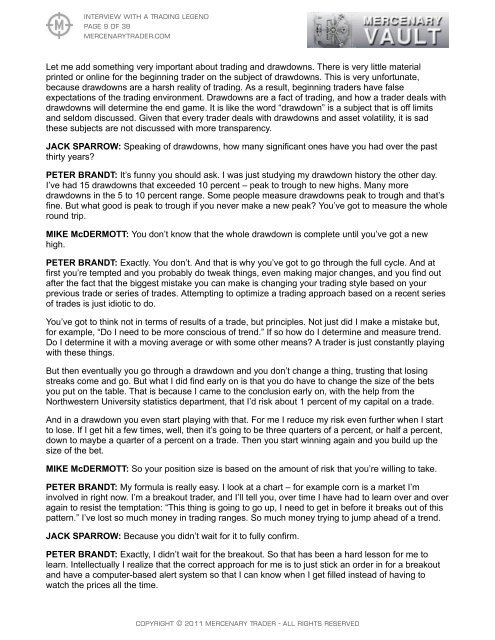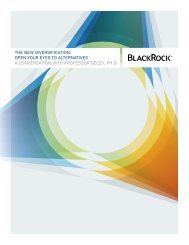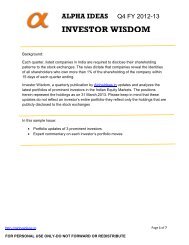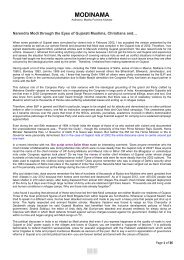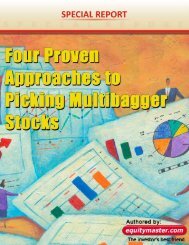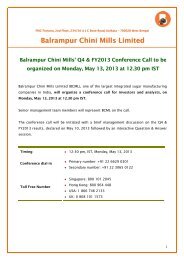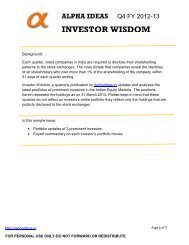Interview With a Trading Legend - Mercenary Trader
Interview With a Trading Legend - Mercenary Trader
Interview With a Trading Legend - Mercenary Trader
You also want an ePaper? Increase the reach of your titles
YUMPU automatically turns print PDFs into web optimized ePapers that Google loves.
<strong>Interview</strong> <strong>With</strong> a <strong>Trading</strong> <strong>Legend</strong><br />
Page 9 of 38<br />
mercenarytrader.com<br />
Let me add something very important about trading and drawdowns. There is very little material<br />
printed or online for the beginning trader on the subject of drawdowns. This is very unfortunate,<br />
because drawdowns are a harsh reality of trading. As a result, beginning traders have false<br />
expectations of the trading environment. Drawdowns are a fact of trading, and how a trader deals with<br />
drawdowns will determine the end game. It is like the word “drawdown” is a subject that is off limits<br />
and seldom discussed. Given that every trader deals with drawdowns and asset volatility, it is sad<br />
these subjects are not discussed with more transparency.<br />
JACK SPARROW: Speaking of drawdowns, how many significant ones have you had over the past<br />
thirty years?<br />
PETER BRANDT: It’s funny you should ask. I was just studying my drawdown history the other day.<br />
I’ve had 15 drawdowns that exceeded 10 percent – peak to trough to new highs. Many more<br />
drawdowns in the 5 to 10 percent range. Some people measure drawdowns peak to trough and that’s<br />
fine. But what good is peak to trough if you never make a new peak? You’ve got to measure the whole<br />
round trip.<br />
MIKE McDERMOTT: You don’t know that the whole drawdown is complete until you’ve got a new<br />
high.<br />
PETER BRANDT: Exactly. You don’t. And that is why you’ve got to go through the full cycle. And at<br />
first you’re tempted and you probably do tweak things, even making major changes, and you find out<br />
after the fact that the biggest mistake you can make is changing your trading style based on your<br />
previous trade or series of trades. Attempting to optimize a trading approach based on a recent series<br />
of trades is just idiotic to do.<br />
You’ve got to think not in terms of results of a trade, but principles. Not just did I make a mistake but,<br />
for example, “Do I need to be more conscious of trend.” If so how do I determine and measure trend.<br />
Do I determine it with a moving average or with some other means? A trader is just constantly playing<br />
with these things.<br />
But then eventually you go through a drawdown and you don’t change a thing, trusting that losing<br />
streaks come and go. But what I did find early on is that you do have to change the size of the bets<br />
you put on the table. That is because I came to the conclusion early on, with the help from the<br />
Northwestern University statistics department, that I’d risk about 1 percent of my capital on a trade.<br />
And in a drawdown you even start playing with that. For me I reduce my risk even further when I start<br />
to lose. If I get hit a few times, well, then it’s going to be three quarters of a percent, or half a percent,<br />
down to maybe a quarter of a percent on a trade. Then you start winning again and you build up the<br />
size of the bet.<br />
MIKE McDERMOTT: So your position size is based on the amount of risk that you’re willing to take.<br />
PETER BRANDT: My formula is really easy. I look at a chart – for example corn is a market I’m<br />
involved in right now. I’m a breakout trader, and I’ll tell you, over time I have had to learn over and over<br />
again to resist the temptation: “This thing is going to go up, I need to get in before it breaks out of this<br />
pattern.” I’ve lost so much money in trading ranges. So much money trying to jump ahead of a trend.<br />
JACK SPARROW: Because you didn’t wait for it to fully confirm.<br />
PETER BRANDT: Exactly, I didn’t wait for the breakout. So that has been a hard lesson for me to<br />
learn. Intellectually I realize that the correct approach for me is to just stick an order in for a breakout<br />
and have a computer-based alert system so that I can know when I get filled instead of having to<br />
watch the prices all the time.<br />
Copyright © 2011 <strong>Mercenary</strong> <strong>Trader</strong> - All Rights Reserved


